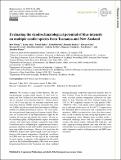Files in this item
Evaluating the dendroclimatological potential of blue intensity on multiple conifer species from Australasia
Item metadata
| dc.contributor.author | Wilson, Rob | |
| dc.contributor.author | Allen, Kathy | |
| dc.contributor.author | Baker, Patrick | |
| dc.contributor.author | Boswijk, Gretel | |
| dc.contributor.author | Buckley, Brendan | |
| dc.contributor.author | Cook, Edward | |
| dc.contributor.author | D'Arrigo, Rosanne | |
| dc.contributor.author | Druckenbrod, Dan | |
| dc.contributor.author | Fowler, Anthony | |
| dc.contributor.author | Grandjean, Margaux | |
| dc.contributor.author | Krusic, Paul | |
| dc.contributor.author | Palmer, Jonathan | |
| dc.date.accessioned | 2021-12-15T17:30:06Z | |
| dc.date.available | 2021-12-15T17:30:06Z | |
| dc.date.issued | 2021-12-14 | |
| dc.identifier | 277039945 | |
| dc.identifier | 2139d555-ab96-480f-9796-a823dbe80586 | |
| dc.identifier | 85121597980 | |
| dc.identifier | 000730601500001 | |
| dc.identifier.citation | Wilson , R , Allen , K , Baker , P , Boswijk , G , Buckley , B , Cook , E , D'Arrigo , R , Druckenbrod , D , Fowler , A , Grandjean , M , Krusic , P & Palmer , J 2021 , ' Evaluating the dendroclimatological potential of blue intensity on multiple conifer species from Australasia ' , Biogeosciences , vol. 18 , no. 24 , pp. 6393–6421 . https://doi.org/10.5194/bg-18-6393-2021 | en |
| dc.identifier.issn | 1726-4170 | |
| dc.identifier.other | ORCID: /0000-0003-4486-8904/work/105006719 | |
| dc.identifier.uri | https://hdl.handle.net/10023/24520 | |
| dc.description | Funding: Rob Wilson was funded through the University of Melbourne Dyason Fellowship in 2014 to undertake preliminary measurement and analyses for this study. We also acknowledge NSF-NERC funding (NE/W007223/1). Kathy Allen was supported by the Australian Research Council grants DP1201040320 and LP12020811 to Patrick Baker. | en |
| dc.description.abstract | We evaluate a range of blue intensity (BI) tree-ring parameters in eight conifer species (12 sites) from Tasmania and New Zealand for their dendroclimatic potential, and as surrogate wood anatomical proxies. Using a dataset of ca. 10–15 trees per site, we measured earlywood maximum blue intensity (EWB), latewood minimum blue intensity (LWB), and the associated delta blue intensity (DB) parameter for dendrochronological analysis. No resin extraction was performed, impacting low-frequency trends. Therefore, we focused only on the high-frequency signal by detrending all tree-ring and climate data using a 20-year cubic smoothing spline. All BI parameters express low relative variance and weak signal strength compared to ring width. Correlation analysis and principal component regression experiments identified a weak and variable climate response for most ring-width chronologies. However, for most sites, the EWB data, despite weak signal strength, expressed strong coherence with summer temperatures. Significant correlations for LWB were also noted, but the sign of the relationship for most species is opposite to that reported for all conifer species in the Northern Hemisphere. DB results were mixed but performed better for the Tasmanian sites when combined through principal component regression methods than for New Zealand. Using the full multi-species/parameter network, excellent summer temperature calibration was identified for both Tasmania and New Zealand ranging from 52 % to 78 % explained variance for split periods (1901–1950/1951–1995), with equally robust independent validation (coefficient of efficiency = 0.41 to 0.77). Comparison of the Tasmanian BI reconstruction with a quantitative wood anatomical (QWA) reconstruction shows that these parameters record essentially the same strong high-frequency summer temperature signal. Despite these excellent results, a substantial challenge exists with the capture of potential secular-scale climate trends. Although DB, band-pass, and other signal processing methods may help with this issue, substantially more experimentation is needed in conjunction with comparative analysis with ring density and QWA measurements. | |
| dc.format.extent | 16103956 | |
| dc.language.iso | eng | |
| dc.relation.ispartof | Biogeosciences | en |
| dc.subject | GE Environmental Sciences | en |
| dc.subject | NDAS | en |
| dc.subject.lcc | GE | en |
| dc.title | Evaluating the dendroclimatological potential of blue intensity on multiple conifer species from Australasia | en |
| dc.type | Journal article | en |
| dc.contributor.sponsor | NERC | en |
| dc.contributor.institution | University of St Andrews. School of Earth & Environmental Sciences | en |
| dc.contributor.institution | University of St Andrews. Scottish Oceans Institute | en |
| dc.contributor.institution | University of St Andrews. St Andrews Sustainability Institute | en |
| dc.identifier.doi | https://doi.org/10.5194/bg-18-6393-2021 | |
| dc.description.status | Peer reviewed | en |
| dc.identifier.url | https://doi.org/10.5194/bg-2021-119 | en |
| dc.identifier.grantnumber | NE/W007223/1 | en |
This item appears in the following Collection(s)
Items in the St Andrews Research Repository are protected by copyright, with all rights reserved, unless otherwise indicated.

